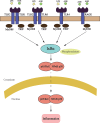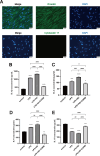CORM-3 Inhibits the Inflammatory Response of Human Periodontal Ligament Fibroblasts Stimulated by LPS and High Glucose
- PMID: 39070135
- PMCID: PMC11277920
- DOI: 10.2147/JIR.S460954
CORM-3 Inhibits the Inflammatory Response of Human Periodontal Ligament Fibroblasts Stimulated by LPS and High Glucose
Abstract
Introduction: Diabetes has been recognized as an independent risk factor for periodontitis. Increasing evidences indicate that hyperglycemia aggravates inflammatory response of human periodontal ligament cells (hPDLCs). Carbon monoxide-releasing molecule-3 (CORM-3) is a water-soluble compound that can release carbon monoxide (CO) in a controllable manner. CORM-3 has been shown the anti-inflammatory effect in different cell lineages.
Methods: We stimulated periodontal ligament cells with LPS and high glucose. The expression of inflammatory cytokine was detected by ELISA. RT-qPCR, Western blot and immunofluorescence were used to detect the expression of TLR2, TLR4, RAGE and the activation of NF-κB pathway. We performed silencing and overexpression treatment of RAGE targeting the role of RAGE. We performed the immunostaining of paraffin sections of the periodontitis model in diabetes rats.
Results: The results showed that CORM-3 significantly inhibited the expression of inflammatory cytokine in hPDLCs stimulated with LPS and high glucose. CORM-3 also inhibited LPS and high glucose-induced expression of RAGE/NF-κB pathway and TLR2/TLR4/NF-κB pathway. Silence of RAGE resulted in significantly decreased expression of proteins above. Overexpression of RAGE significantly enhanced the expression of these factors. CORM-3 abrogated the effect of RAGE partially. In animal model, CORM-3 suppressed the inflammatory response of periodontal tissues in experimental periodontitis of diabetic rats.
Discussion: Our research proved CORM-3 reduced the inflammatory response via RAGE/NF-κB pathway and TLR2/TLR4/NF-κB pathway in the process of high glucose exacerbated periodontitis. These findings demonstrated the role of RAGE in the process of high glucose exacerbated periodontitis and suggested that CORM3 be a potential therapeutic strategy for the treatment of diabetes patients with periodontitis.
Keywords: carbon monoxide-releasing molecules; diabetes; lipopolysaccharide; periodontitis; receptor for advanced glycation end products.
© 2024 Tian et al.
Conflict of interest statement
The authors declare no conflicts of interest in this work.
Figures








References
LinkOut - more resources
Full Text Sources

